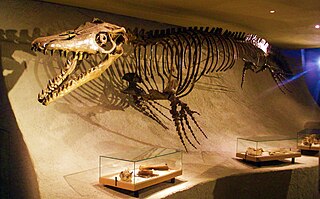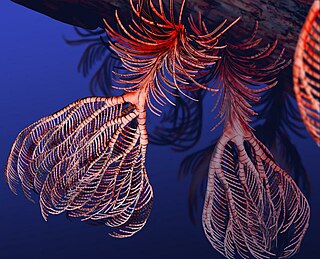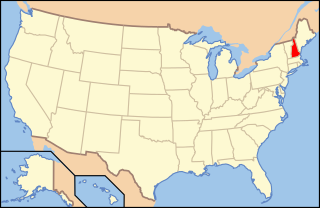
Crinoids are marine animals that make up the class Crinoidea. Crinoids that are attached to the sea bottom by a stalk in their adult form are commonly called sea lilies, while the unstalked forms, called feather stars or comatulids, are members of the largest crinoid order, Comatulida. Crinoids are echinoderms in the phylum Echinodermata, which also includes the starfish, brittle stars, sea urchins and sea cucumbers. They live in both shallow water and in depths as great as 9,000 meters (30,000 ft).

Mosasaurus is the type genus of the mosasaurs, an extinct group of aquatic squamate reptiles. It lived from about 82 to 66 million years ago during the Campanian and Maastrichtian stages of the Late Cretaceous. The earliest fossils of Mosasaurus known to science were found as skulls in a chalk quarry near the Dutch city of Maastricht in the late 18th century, which were initially thought to have been the bones of crocodiles or whales. One skull discovered around 1780, which was seized by France during the French Revolutionary Wars for its scientific value, was famously nicknamed the "great animal of Maastricht". In 1808, naturalist Georges Cuvier concluded that it belonged to a giant marine lizard with similarities to monitor lizards but otherwise unlike any known living animal. This concept was revolutionary at the time and helped support the then-developing ideas of extinction. Cuvier did not designate a scientific name for the new animal, and this was done by William Daniel Conybeare in 1822 when he named it Mosasaurus in reference to its origin in fossil deposits near the Meuse River. The exact affinities of Mosasaurus as a squamate remain controversial, and scientists continue to debate whether its closest living relatives are monitor lizards or snakes.

Hypsibema is a little-known genus of dinosaur from the Late Cretaceous. Its giant fossils were found in the U.S. states of North Carolina and possibly Missouri. It is believed to be a hadrosauroid, although the Missouri remains were first thought to belong to a small sauropod.

Pentacrinites is an extinct genus of crinoids that lived from the Hettangian to the Bathonian of Asia, Europe, North America, and New Zealand. Their stems are pentagonal to star-shaped in cross-section and are the most commonly preserved parts. Pentacrinites are commonly found in the Pentacrinites Bed of the Early Jurassic of Lyme Regis, Dorset, England. Pentacrinites can be recognized by the extensions all around the stem, which are long, unbranching, and of increasing length further down, the very small cup and 5 long freely branching arms.

The Ripley Formation is a geological formation in North America found in the U.S. states of Alabama, Georgia, Mississippi, Missouri, and Tennessee. The lithology is consistent throughout the layer. It consists mainly of glauconitic sandstone. It was formed by sediments deposited during the Maastrichtian stage of the Late Cretaceous. It is a unit of the Selma Group and consists of the Cusseta Sand Member, McNairy Sand Member and an unnamed lower member. It has not been extensively studied by vertebrate paleontologists, due to a lack of accessible exposures. However, fossils have been unearthed including crocodile, hadrosaur, nodosaur, tyrannosaur, ornithomimid, dromaeosaur, and mosasaur remains have been recovered from the Ripley Formation.

Hypsibema missouriensis is a species of plant-eating dinosaur in the genus Hypsibema, and the state dinosaur of the U.S. state Missouri. One of the few official state dinosaurs, bones of the species were discovered in 1942, at what later became known as the Chronister Dinosaur Site near Glen Allen, Missouri. The remains of Hypsibema missouriensis at the site, which marked the first known discovery of dinosaur remains in Missouri, are the only ones to have ever been found. Although first thought to be a sauropod, later study determined that it was a hadrosaur, or "duck-billed" dinosaur, whose snouts bear likeness to ducks' bills. Some of the species' bones found at the Chronister Dinosaur Site are housed in Washington, D.C.'s Smithsonian Institution.
Fossils of many types of water-dwelling animals from the Devonian period are found in deposits in the U.S. state of Michigan. Among the more commonly occurring specimens are bryozoans, corals, crinoids, and brachiopods. Also found, but not so commonly, are armored fish called placoderms, snails, sharks, stromatolites, trilobites and blastoids.

Encrinus is an extinct genus of crinoids, and "one of the most famous". It lived during the Late Silurian-Late Triassic, and its fossils have been found in Europe.

Paleontology in Indiana refers to paleontological research occurring within or conducted by people from the U.S. state of Indiana. Indiana's fossil record stretches all the way back to the Precambrian, when the state was inhabited by microbes. More complex organisms came to inhabit the state during the early Paleozoic era. At that time the state was covered by a warm shallow sea that would come to be inhabited by creatures like brachiopods, bryozoans, cephalopods, crinoids, and trilobites. During the Silurian period the state was home to significant reef systems. Indiana became a more terrestrial environment during the Carboniferous, as an expansive river system formed richly vegetated deltas where amphibians lived. There is a gap in the local rock record from the Permian through the Mesozoic. Likewise, little is known about the early to middle Cenozoic era. During the Ice Age however, the state was subject to glacial activity, and home to creatures like short-faced bears, camels, mammoths, and mastodons. After humans came to inhabit the state, Native Americans interpreted the fossil proboscidean remains preserved near Devil's Lake as the bones of water monsters. After the advent of formal scientific investigation one paleontological survey determined that the state was home to nearly 150 different kinds of prehistoric plants.

Paleontology in Illinois refers to paleontological research occurring within or conducted by people from the U.S. state of Illinois. Scientists have found that Illinois was covered by a sea during the Paleozoic Era. Over time this sea was inhabited by animals including brachiopods, clams, corals, crinoids, sea snails, sponges, and trilobites.

Paleontology in Vermont comprises paleontological research occurring within or conducted by people from the U.S. state of Vermont. Fossils are generally uncommon in Vermont. Nevertheless, however, significant finds have been made in the state. Very few fossils are known in Vermont east of the Green Mountains due to the type of rock underlying that area. During the early part of the Paleozoic era, Vermont was covered by a warm, shallow sea that would end up being home to creatures like brachiopods, corals, crinoids, ostracoderms, and trilobites. There are no rocks in the state from the Carboniferous, Permian, Triassic, or Jurassic periods. The few Cretaceous rocks present contain no fossils. The Paleogene and Neogene periods are also absent from the local rock record. During the Ice Age, glaciers scoured the state. At times the state was inundated by seawater, allowing marine mammals to venture in. After the seawater drained away the state was home to mastodons. Local fossils had already attracted scientific attention by the mid-19th century when mastodon remains were found in Rutland County. In 1950 a major Paleozoic invertebrate find occurred. The Pleistocene Beluga whale Delphinapterus leucas is the Vermont state fossil.

Paleontology in New Hampshire refers to paleontological research occurring within or conducted by people from the U.S. state of New Hampshire. Fossils are very rare in New Hampshire because so much of the state's geology is highly metamorphic. The state's complicated geologic history has made dating its rocks and the fossils they contain "a difficult task." The state's Devonian rocks are especially metamorphosed, yet its Mississippian rocks formed too recently to have been subject to the same metamorphism. Nevertheless, despite the geologic complications some fossils have been discovered in the state.

Paleontology in Wisconsin refers to paleontological research occurring within or conducted by people from the U.S. state of Wisconsin. The state has fossils from the Precambrian, much of the Paleozoic, and the later part of the Cenozoic. Most of the Paleozoic rocks are marine in origin. Because of the thick blanket of Pleistocene glacial sediment that covers the rock strata in most of the state, Wisconsin’s fossil record is relatively sparse. In spite of this, certain Wisconsin paleontological occurrences provide exceptional insights concerning the history and diversity of life on Earth.

Paleontology in Missouri refers to paleontological research occurring within or conducted by people from the U.S. state of Missouri. The geologic column of Missouri spans all of geologic history from the Precambrian to present with the exception of the Permian, Triassic, and Jurassic. Brachiopods are probably the most common fossils in Missouri.

Paleontology in Iowa refers to paleontological research occurring within or conducted by people from the U.S. state of Iowa. The paleozoic fossil record of Iowa spans from the Cambrian to Mississippian. During the early Paleozoic Iowa was covered by a shallow sea that would later be home to creatures like brachiopods, bryozoans, cephalopods, corals, fishes, and trilobites. Later in the Paleozoic, this sea left the state, but a new one covered Iowa during the early Mesozoic. As this sea began to withdraw a new subtropical coastal plain environment which was home to duck-billed dinosaurs spread across the state. Later this plain was submerged by the rise of the Western Interior Seaway, where plesiosaurs lived. The early Cenozoic is missing from the local rock record, but during the Ice Age evidence indicates that glaciers entered the state, which was home to mammoths and mastodons.

Paleontology in the United States refers to paleontological research occurring within or conducted by people from the United States. Paleontologists have found that at the start of the Paleozoic era, what is now "North" America was actually in the southern hemisphere. Marine life flourished in the country's many seas. Later the seas were largely replaced by swamps, home to amphibians and early reptiles. When the continents had assembled into Pangaea drier conditions prevailed. The evolutionary precursors to mammals dominated the country until a mass extinction event ended their reign.

Agaricocrinus americanus, the mushroom crinoid, is a species of extinct crinoid, known only from its fossils, which are found in the U.S. states of Indiana, Tennessee and Kentucky. They date back to the Lower Mississippian, about 345 million years ago.

The Kimmswick Limestone is an Ordovician geologic formation in Arkansas, Illinois and Missouri. Fossils occurring in the Kimmswick include corals, bryozoans, brachiopods, conodonts, trilobites, crinoids and mollusks.

The Burlington Limestone is a geologic formation in Missouri, Iowa and the Midwest region. It preserves fossils dating back to the Mississippian subperiod.

















